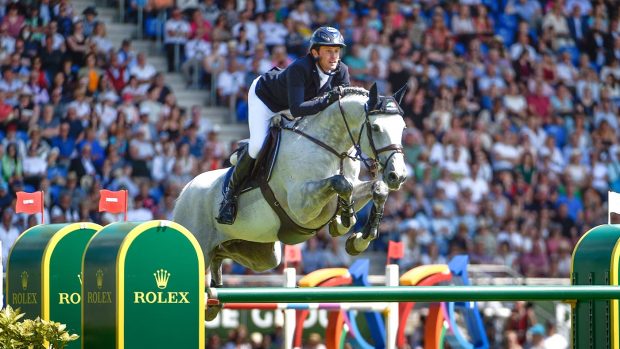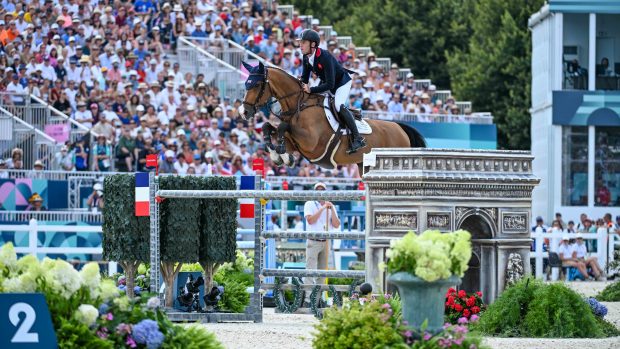A woman is yet to claim individual Olympic gold in either eventing or showjumping. Andrea Oakes investigates the reasons behind this...
THEY dominate in Olympic dressage, but where are the women at the top of the podium in showjumping and eventing?
It’s a little-known fact that there has never yet been a female Olympic individual gold medallist in either of these two disciplines. A few riders have come close, including Sweden’s Sara Algotsson Ostholt (pictured), who had to settle for individual eventing silver in London in 2012 after rolling a pole at the last fence in the final phase, and women have appeared on winning teams. But even if we only go back as far as the 1964 Games (the first time that females were permitted to compete in Olympic eventing, eight years after the doors opened to them in showjumping), that’s still 14 consecutive male victories in each discipline.
Considering that the current world champions in dressage, showjumping and eventing are all female, it’s an interesting anomaly. But many believe it’s purely down to numbers. Because male competitors outnumber females in the top 100 world rankings in these sports, fewer women reach selection to stand a chance of winning a medal. This is certainly true in showjumping, where females comprise fewer than 20% of the top 100, and only five females have taken home an individual Olympic medal of any colour.
Dr Kate Dashper, an associate professor at Leeds Beckett University, has identified further factors: “Lack of an individual Olympic gold is, in part, related to the prestige of the event,” she explains. “Once we get to selection, the processes are strict and are based not only on performance, but also on networks.
“Showjumping in particular requires a huge depth of financial support; you need a real string,” she says. “The names we see selected, especially in the UK, have usually been around for a long time, while the younger riders who have broken through, such as Ben Maher and Scott Brash, have solid support.”
Kate believes that this bias, while not deliberate, favours men.
“I don’t think motherhood holds people back, because why do we see so many successful mothers in eventing?” she says. “And
to say women don’t have the mental toughness doesn’t hold when you look at the medals they’ve won in dressage. But there are so many subtle factors in the Olympic build-up, including support networks, ownership and sponsorship. It’s not just about being the best.”
Is motherhood influential?
LUCY DUMBELL, a Hartpury University doctoral researcher who profiles elite riders, agrees that reaching the pinnacle in any discipline requires long-term stability and financial support – enabling an athlete to focus on the their performance.
“This is especially true in showjumping, which has a slightly different culture to eventing,” she says. “In the research I’ve been reading and conducting, showjumping has a more ‘business’ feel and a greater connection with sponsorship and ownership.
“In other sports, men are considered a slightly safer bet in advertising campaigns and when attracting sponsors,” she adds, pointing out that showjumping horses in particular are worth a huge amount of money. “Equestrianism is a diverse sport, but, in general, male and female athletes heading to the top may experience different challenges.”
How influential is the fact riders may consider motherhood at the top of their career?
“This does have an impact,” she says. “I don’t think we really know how these things interact, but there are more hurdles present for females. Even though eventing may be physically challenging as a female athlete, that can be overcome with personal effort. But some of the cultural and commercial issues are out of a rider’s control.”
While we’ve not yet seen individual Olympic gold in eventing, female riders won both silver and bronze in 2004, 2008 and 2012. Tina Cook, who took bronze for Britain in 2008 with Miners Frolic, believes that motherhood has historically held women back.
“Mary King was one of the first to prove it was possible to return to the sport after having children. Until then, the high-profile women – the winning women – typically gave up international competition after starting a family,” says Tina, whose mother Althea Gifford, a top showjumper in the 1960s, did just that. “There is only a short slot in your career between becoming a senior rider and thinking about a family. With the Olympics happening every four years, I suppose that not that many women had the opportunity to win medals.
“If I hadn’t returned to the sport after having children, I wouldn’t have my Olympic medals,” adds Tina, who also took team bronze that year and team silver in 2012. “My owners supported and trusted me, believing that I could be a mother and still be competitive, but it is tough at times trying to be both.”
Lucinda Green, a team eventing silver medallist in 1984, has another theory.
“Watching Rio [in 2016], it did cross my mind that strength was becoming a crucial part of cross-country riding – as we saw Phillip Dutton achieve the almost impossible by manhandling his horse through a narrow gap at a fence that the horse had basically run out at,” she says. “That would give men the edge, as does the fact that many of them have supportive wives.”
“We’ve always had good female eventers to act as role models,” adds Lucy, who feels that progress towards redressing the balance in showjumping may be slower. “There is now an increased appetite for women as athletes, with more securing sponsorship deals and advertising. With eventing, we’re awaiting that breakthrough with individual gold.”
Diarmiud Byrne of sports data analytics company Equiratings believes the male domination in Olympic eventing “feels more like chance than anything deeper. Our last two world champions [are female] and Ingrid Klimke is the double European champion,” he says. “It was only a single rail that cost Sara Algotsson Ostholt gold in London.
“Almost every major nation will have a female rider with the potential to win either team or individual gold in 2021 in eventing. I’d think the run might be over for the boys.”
What about showjumping?
THERE are a handful of brilliant women in showjumping, too. Germany’s Simone Blum, the current world champion, was widely tipped for a Tokyo medal before injury ruled out her top prospect DSP Alice. France’s Pénélope Leprevost, an Olympic team gold medallist in Rio, is still in the running, while 2008 individual bronze medallist Beezie Madden was among six women on the 10-strong US Olympic team shortlist. Both Laura Kraut and Jessica Springsteen will be heading to Tokyo.
The question remains as to why female showjumpers are still so outnumbered.
“When it comes to the nitty-gritty, at the top end of the sport, men do seem to have an advantage,” says showjumping trainer and commentator Andy Austin. “Men are physically stronger and maybe they want to win that bit more. We don’t see too many women competing week in, week out with eight to 10 horses. Perhaps they tend to focus on fewer, so they’re in tune with one or two.
“But there is every chance of a woman beating the men at the Olympics,” adds Andy. “When a female rider has a special relationship with a horse, as with Simone and DSP Alice, they can achieve anything.”
Graham Fletcher feels that the intensity of today’s international circuit is a key factor.
“It’s relentless,” he says, of the travelling and time away from home required to stay high up the rankings. “When kids start out in the sport, there are typically a lot more girls, but when you reach professional status, the percentages swing the other way. That’s probably down to lifestyle choices. Maybe girls feel more family responsibility, or are more likely to consider the impact of a bad accident. It’s tough, make no mistake.”
Despite the odds, Graham believes we will soon see a female Olympic individual gold medallist: “I would rank the two American riders, Beezie Madden and Laura Kraut, as up there with the greats – men or women,” he says. “They have as good a chance as any, if they can make an Olympic final.”
The last British female on an Olympic showjumping team before Holly Smith got the Tokyo call-up was Debbie Johnsey, in 1976.
“It would be good to change the trend in Tokyo, but the cutting of team numbers to three won’t help,” says former showjumper and current Team GBR performance manager Di Lampard. “We have seen predominantly male championship riders, but women have been coming through at the worlds and Europeans and more are making it on to teams.
“It isn’t easy to have a championship horse at the right age for the Games every four years,” adds Di. “A lot of females are good with one horse, but they need a string. They need help to stay at the level and continued support from owners, but also the determination to stick at it.
“The ladies are getting there. Just look at racing,” she says, referring to the sea change in a notoriously male-dominated sport, where Rachael Blackmore made history this year with a Grand National win. “The door has never been more open.”
This exclusive feature can also be read in Horse & Hound magazine, on sale date Thursday 1 July 2021
You may also be interested in…

‘The Brits pulled it out of the bag’: Peter Storr reviews the Olympic team dressage

H&H Olympic reporter’s blog: ‘We were standing with Jessica von Bredow-Werndl when she found out she’d won gold’

H&H’s Tokyo rider of the day: Kelly Layne on her ‘rockstar who just wanted to hide’

Subscribe to Horse & Hound magazine today – and enjoy unlimited website access all year round



